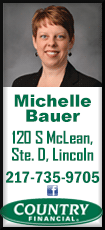Nestle, Unilever forego price increases to move product
 Send a link to a friend
Send a link to a friend
 [April 19, 2018]
By Silke Koltrowitz and Martinne Geller [April 19, 2018]
By Silke Koltrowitz and Martinne Geller
ZURICH/LONDON (Reuters) - First-quarter
sales growth at Nestle and Unilever was driven almost entirely by
shifting more goods, in a stark illustration of how hard it is for
consumer products makers to raise prices in a competitive retail
environment.
Multinational makers of everything from soup to soap are under pressure
to boost revenues as consumers flock to fresher products and newer
brands. The large retailers they sell through face their own pressure to
keep prices down, as they battle new competition from drug stores and
Amazon.com.
The result has been mounting tension, which recently erupted in a clash
between Nestle and European retailers that saw some of the Swiss
company's goods briefly taken off store shelves. That row was itself an
echo of a 2016 standoff between Unilever and British supermarket giant
Tesco.
On Thursday, results from both manufacturers suggested those tensions
remain high. Nestle's 2.8 percent underlying sales growth only got a 0.2
percent boost from higher prices, and Unilever's 3.4 percent growth just
a 0.1 percent lift.

"We expect chronically weak pricing from both Unilever and Nestle to
play to the market's fears of weak pricing power, fueled by channel
shift, in the face of rising commodities (prices)," Jefferies analyst
Martin Deboo said.
The pricing pressure was even tougher for U.S. giant Procter & Gamble,
which on Thursday reported just a 1 percent rise in underlying quarterly
sales growth.
That included a 2 percent hit from lower prices, offset by higher
volumes and other factors. The maker of Gillette razors cut some prices
last year amid competition from subscription-based rivals such as Dollar
Shave Club, owned by Unilever, and Harry's.
Unilever shares were down 2 percent, while Nestle's were up 0.3 percent,
as investors looked past the pricing issue at the Swiss food giant to
the fact its overall sales exceeded expectations after several
disappointing quarters.
That beat, and a pick-up in volume, is welcome news for Nestle's new CEO
Mark Schneider, who took the top job at the maker of KitKat chocolate
bars and Maggi soups in 2017 with the mission to return it to solid
growth after six years of decline.
Schneider said underlying growth would improve during 2018.
Consumer sentiment in Europe, as measured by researchers GfK, declined
in March to a reading of 20.6 points from 21.1 points in December.
"The mood of European consumers is proving to be rather less optimistic
in the first quarter of 2018 than at the end of last year," the group
said on Thursday. "In France and Austria, in particular, the euphoria
appears to have diminished temporarily in the wake of the elections."

WANING PRICING POWER?
Consumer goods makers and retailers are always in complex negotiations
around pricing and promotions to suit their ambitions. If a manufacturer
wants to take market share, it might discount, or seek price increases
to boost margins.
[to top of second column] |

Nestle confectionary
products - including BreakAway, KitKat, Smarties, Blue Riband, Fruit
Pastilles and Randoms - are seen in a bowl at the company's Product
Technology Centre in York, Britain, March 21, 2018. REUTERS/Phil
Noble/File Photo

Russ Mould, investment director at AJ Bell, said trends suggested Unilever and
some of its peers had "blinked a little" on pricing due to growing competition,
even though they represent powerful, established brands.
"Brands are still a vital part of any company's pricing power armory but ...
some companies are stronger in the food chain than others, depending on size,
route to market and the availability of alternatives," Mould said.
Nestle and Unilever are two of the world's biggest packaged goods companies,
with the Swiss giant home to Gerber baby food and Perrier water, and its
Anglo-Dutch rival the company behind Dove soap and Ben & Jerry's ice cream.
This is Unilever's second quarter of volume-led sales growth, after several
quarters fueled by pricing. Finance chief Graeme Pitkethly said the earlier
price rises, and corresponding weak volume, were partly due to currency-related
inflationary pressures in certain markets that have since abated, giving
consumers more confidence to spend on everyday items.
As a result, sales volume in emerging markets, where Unilever does the majority
of its sales, was ahead of expectations, according to Barclays analysts.
"The good news is when you have more muted pricing, more consumers buy more of
your brands," Pitkethly said, adding that minimal commodity price inflation had
also inhibited the ability to raise prices.
He said the main pricing trouble spots were Brazil and Indonesia, which both saw
prices fall due to weak consumer sentiment; India, due to a tax change put
through last year; and Britain, where retail competition is fierce.
These four countries make up 25 percent of Unilever's sales, Pitkethly said.
Other countries, such as Turkey and Mexico, saw a good balance, he said.

The overall balance of price and volume would improve in the second half of the
year, Pitkethly said.
Both companies confirmed their sales guidance for the year, with Nestle aiming
for 2-4 percent underlying sales growth and Unilever looking for 3-5 percent
growth. Unilever said growth in the second quarter would be near the lower end
of the range.
Nestle also said it was on track to return to mid-single-digit underlying sales
growth by 2020.
Nestle highlighted a return to volume growth in the Americas, helped by strong
petcare and coffee creamers sales, while growth in Asia benefited from the
timing of the Chinese New Year.
Unilever also called out a strong start in North America, helped by innovations
such as the new brand Love Beauty and Planet and acquisitions such as Dollar
Shave Club.
(Editing by Mark Potter)
[© 2018 Thomson Reuters. All rights
reserved.] Copyright 2018 Reuters. All rights reserved. This material may not be published,
broadcast, rewritten or redistributed.
Thompson Reuters is solely responsible for this content. |